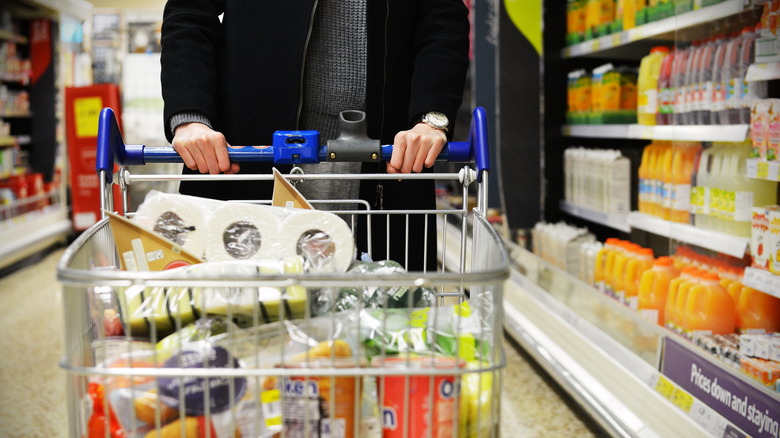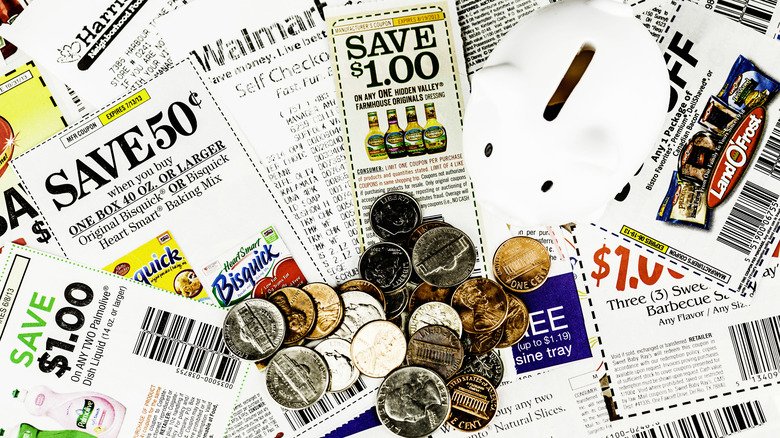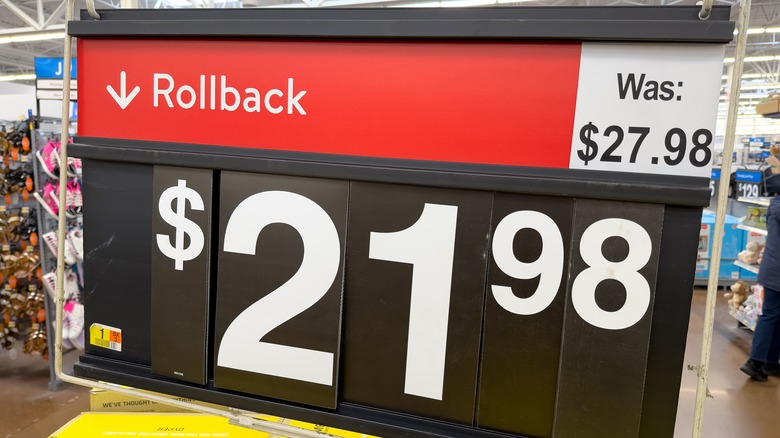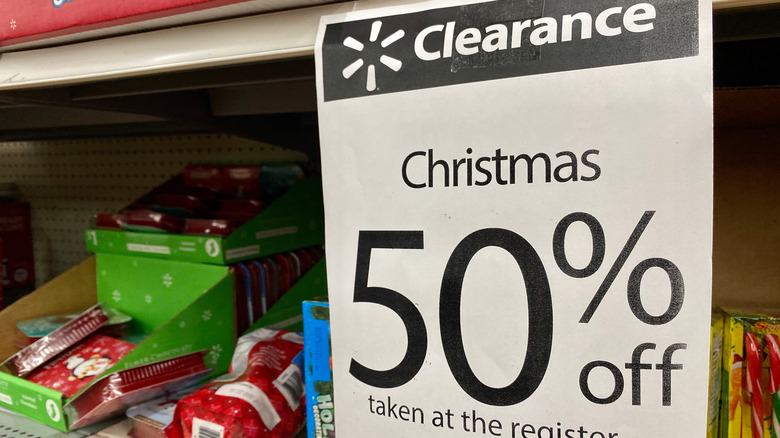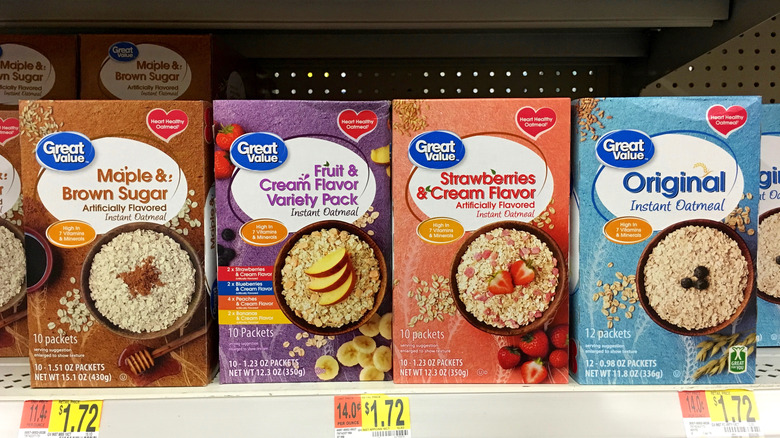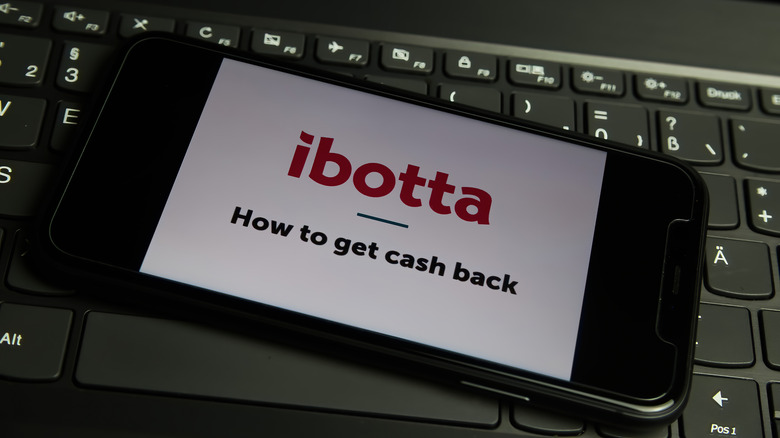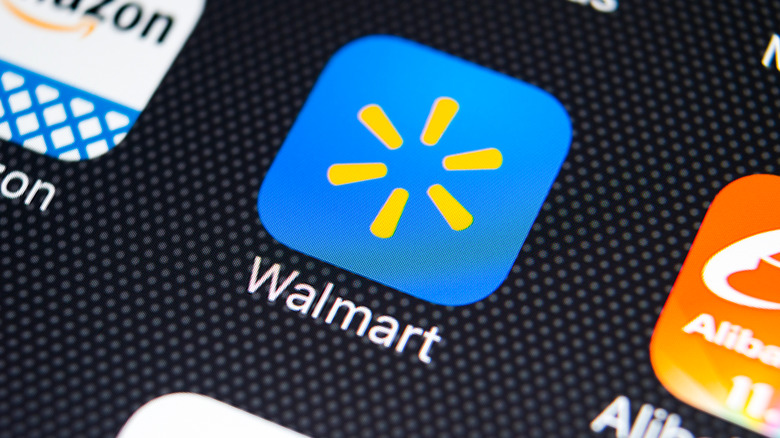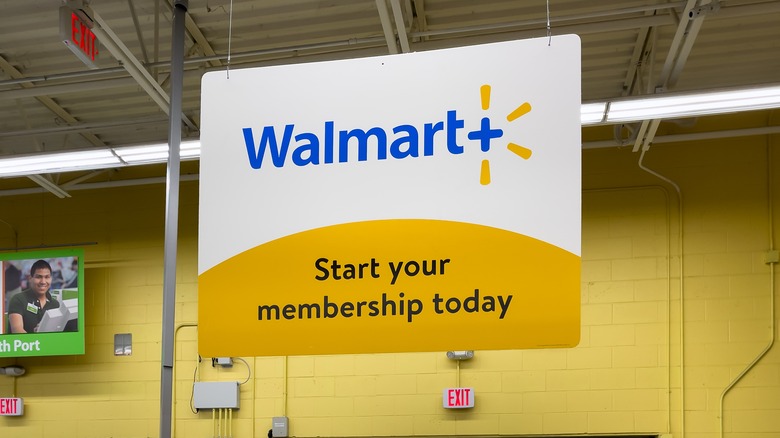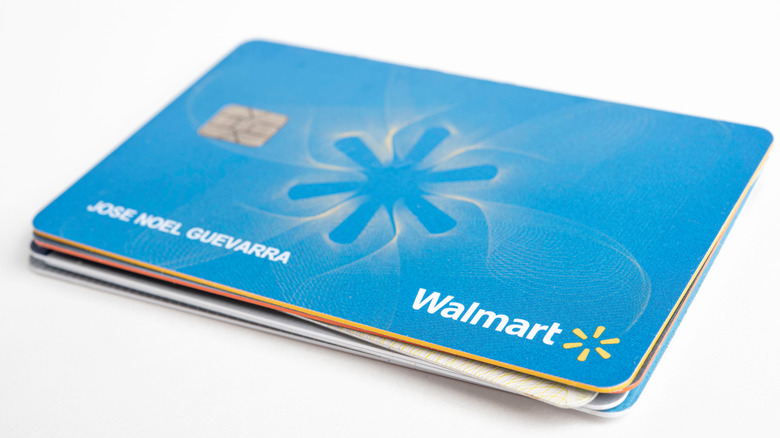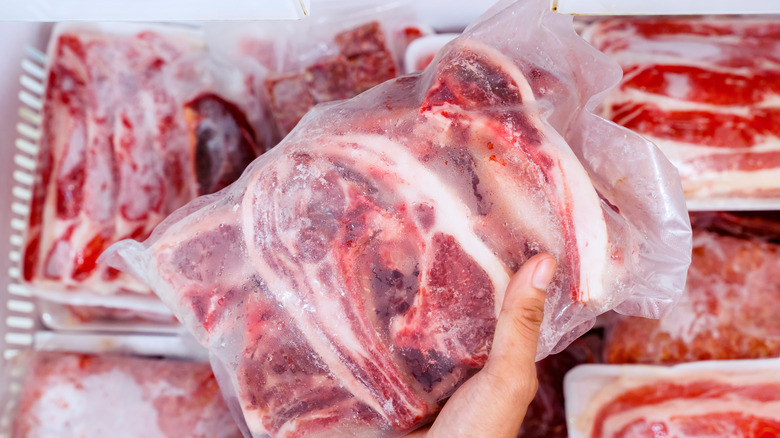The 11 Best Ways To Avoid Overpaying At Walmart
Since the grand opening of the first Walmart in 1962, this big box store has transformed into a global enterprise and is one of the most recognizable hypermarkets in America. A beloved household name to millions of shoppers, the Walmart concept is quite simple — fresh, high-quality food at affordable prices, right at your fingertips. But, what happens when that idealistic model comes crumbling down and you find yourself reeling in disbelief at the total amount printed on your receipt?
Food costs are more expensive than ever before, and this trend doesn't appear to be slowing down anytime soon. Nothing is spared from these current grocery price hikes, from meat to eggs to cereal. No matter what the experts say, everyone is feeling the burn of expensive groceries, even Walmart loyalists who have always benefited from lower-than-average grocery prices. So, what gives? What is the solution?
If you're tired of overpaying for your Walmart groceries, you might just be in luck. Hidden within the depths of frugality are some tips and tricks that can help you save money when you shop at Walmart. While the savings may seem negligible at first, over time, you will see the fruits of your efforts pay off. Your wallet will thank you in the long run.
1. Use coupons
Couponing is more than just a one-off gimmick to save a buck or two on your favorite snacks. It is a lifestyle and a strategic, rewarding way to safeguard your wallet from overpaying. Once you've mastered the ins and outs of couponing like the aficionados, you will be well on your way to unimaginable savings next time you shop. Everyone must start somewhere on their journey to end overpaying on Walmart groceries, and couponing is the first step to making that dream a reality.
If you want to harness the power of coupons and transform a simple grocery run into a savvy financial endeavor, you must first know where to secure them. The most traditional route is newspaper clippings, which offer savings on all your favorite Walmart food items. You'd be surprised by what you might find in the local paper. In the 21st century, finding coupons through digital sources is much more common. There are entire websites devoted to both downloadable and digital-only coupons, like Coupons.com, RetailMeNot, and The Krazy Coupon Lady. You can even find hidden gems on social media platforms if you look hard enough.
The art of successful couponing lies in combining these diverse resources to maximize your Walmart food savings, helping you make the most of your grocery budget so that you can shop smarter without compromising food quality.
2. Buy items on rollback
Have you ever walked into a Walmart, saw those red rollback signs, and wondered what they meant? Well, what they mean is more cash in your pocket, but only for a limited time. Walmart's rollback items are products that have their price substantially reduced, but those reduced prices will eventually return to their original cost after the rollback period ends. When it comes to rollback foods, it's all about timing and a bit of urgency.
With constant fluctuations and price increases on food in today's market, rollback items provide a consistent way to access savings on essential and premium food products. Whether it's fresh produce, pantry staples, or other household necessities, you can try curating your shopping list on the go based on what is currently on rollback. While your shopping cart might look slightly different from week to week, being open to different or alternative foods can actually save you money and diversify your palate.
Keep your eyes peeled for items marked with the rollback sign or sticker. Your local Walmart might also have a section dedicated to rollback food items, so check that out, too. Once you commit to buying rollback, these well-timed discounts will become an essential tool in your arsenal and turn you into a bona fide budget-conscious shopper.
3. Buy clearance items
It's time to unlock a treasure trove of savings and stop overpaying on your grocery bill, so what better way to do that than with Walmart's clearance items? Like rollback, these hidden gems are usually scattered throughout the store, so sometimes you must dig a little to uncover where they are. When you do, you can buy premium, high-quality food at a fraction of their regular price. There's often a clearance section, too, where you can find a variety of low-price foods all in one convenient location.
The caveat of clearance items is that they're only priced low so that they can sell fast. Once these items are gone, they're gone for good. In retail, products undergo seasonal transitions, and Walmart makes inventory adjustments like any other store. Displaced items are marked down to make room for new arrivals. So, this cyclic phenomenon can spell significant savings if you're willing to embrace Walmart's clearance items as a part of your shopping strategy.
Vigilance and curiosity pay off, but it's no rush. As you explore each aisle, take your time to unearth substantial discounts. Also, be on the lookout for hidden clearance items, which are just clearance items that haven't had their price tag changed yet in store. With the Walmart app, you can scan these foods to see which ones are on clearance even if the price tag on the shelf doesn't accurately reflect the correct, discounted price.
4. Look for damaged and reduced price items
Amid the hustle and bustle of the grocery aisles on a busy weekday evening, Walmart's damaged undesirables are your golden ticket to reduced prices. You can usually find these unassuming, money-saving heroes tucked away on shelves, pushed forward by the Walmart stockers but left on their lonesome as shoppers shuffle past them time and time again. These damaged products present a unique opportunity to secure foods at a reduced price.
Usually, these food items bear only superficial imperfections, such as slightly bruised fruit or packaging mishaps like dented cans. Consumers are visual beings, so these flaws are often misinterpreted as something to avoid. The truth is that their edibility and value, more often than not, remain intact. So, as a customer striving to transform into a more budget-conscious Walmart shopper, you can enjoy savings without compromising quality. As the saying goes, "Don't judge a book by its cover."
The allure of damaged, reduced-price items lies in their dual benefits. For one, they translate to immediate savings, but buying them is also a way to contribute to sustainable consumption practices. You give a second life to food items that might otherwise be discarded because no one wants to buy them. It's a wallet-friendly way to minimize waste and save money. That sounds like a win-win.
5. Buy generic or store brand goods
There's no denying it — name-brand foods have a unique appeal that makes them more attractive to the average shopper. Whether it's a reliable product you've come to love or it has a distinctive taste that's hard to find anywhere else, name brands are a staple of many people's weekly shopping lists because they're trusted.
But, if you're serious about achieving big savings at Walmart, consider giving generic or store-brand items a try. That's where Great Value comes in. This is Walmart's cost-efficient, generic alternative to the name-brand versions of all your favorite foods. While they may not bear the flashy packaging of their popular, name-brand counterparts, the differences are pretty negligible in the grand scheme of it all. In most cases, Great Value offers the same quality and taste. Do you really need Quaker oatmeal when you can get the Great Value version at almost half the price?
Now, some people just prefer name-brand products, and that's okay. Making the conscious decision to explore outside of this territory can help relieve some of the financial burden off your grocery bill, and that's the main goal, right? You don't have to switch entirely to generic or Great Value foods. Sometimes, it's just a matter of trial and error as you try out new generic items and discover the ones you genuinely enjoy.
6. Use rebate and cash-back apps
Navigating the modern shopping experience isn't always easy these days. Luckily, rebate and cash-back apps have proven to be a formidable ally in the quest against overpaying for Walmart groceries. Among them, Ibotta, in partnership with Walmart, offers a unique approach that empowers shoppers to unlock discounts and cash rewards, seamlessly integrating grocery lists with tailored offers to transform routine food purchases into savings victories.
The beauty of these apps lies in their simplicity. As you browse the grocery aisles of your local Walmart, your smartphone is a gateway to unlock exclusive mobile savings. Before you shop, add all the offers you plan to buy into the Ibotta or Walmart app. After making your purchases, upload the receipt to either app and receive cash back on qualifying purchases. That's all there is to seeing your earnings soar.
While Ibotta is the most popular cash-back and rebate app, there are other options worth checking out for quick savings. Fetch Rewards is excellent because you don't have to select offers beforehand. Upload your receipts for points and then cash out those points for money back. You can also cash out immediately with Coupons.com's app for a hassle-free rebate experience.
7. Download the Walmart mobile app
Walmart's entire business model is about consumers accessing unimaginable savings. It's in the company's motto, after all — "Save money. Live better." As a testament to Walmart's commitment to enhancing your cost-effective shopping experience, the retailer's mobile app is a transformative tool at the heart of this modern digital revolution, allowing you to compare prices, access exclusive offers, and even create personalized shopping lists while on the go.
The Savings Catcher is at the core of Walmart's mobile app, a remarkable integrated feature that ensures you never overpay for groceries. It's so easy — just scan your receipt, and the app intuitively compares competitor prices against the items you purchased. If the app finds a lower price at another retailer, you're rewarded with the difference, giving you the best possible prices without having to shop around everywhere for those deals.
The Walmart app and Savings Catcher feature aren't just about convenience; they're about taking charge of your finances and guarding against overpaying for your groceries. The goal is to optimize every shopping experience to ensure your purchases stay within budget, synergize with your shopping interests, and give you the confidence to shop till you drop like a pro.
8. Take advantage of Walmart Plus Week
Like Amazon Prime Day, Walmart has an annual event providing some of the biggest sales. Cue in Walmart Plus Week, several days of celebration where shoppers can access unprecedented savings and extract the most value from their favorite grocery items. During this event, products are significantly discounted and remain that way for the entire sale duration: no coupon scanning, no rebates, just plain ole price reductions across the board.
The best part is that everyone can participate in Walmart Plus Week. If you have a Walmart+ membership, even better. Members get early access to the deals before everyone else, allowing them to leverage their membership for a more streamlined shopping experience. With memberships currently costing only around $8 a month, this small expense can pave the way for crazy discounts that'll make you squeal with glee.
The other great benefit is that Walmart+ members get unlimited free delivery and shipping on their groceries. So when Walmart unveils the next Walmart Plus Week, all those discounted groceries can be delivered right to your doorstep at no extra cost, saving you time, money, and energy. This event is truly a perfect confluence of smart savings and unparalleled convenience, so take advantage of it to the fullest.
9. Double check the price during checkout
Have you heard of the Walmart self-checkout scam? No? Well, here's the deal. Imagine you're a Walmart customer checking out your items at the self-checkout kiosk. Everything seems normal, nothing is afoul, and all is well, right? You suddenly realize that several of your items are ringing up for a much higher price than they should be. If you see a purchase description on your receipt that reads "debit load" or some random credit card name like "Visa," you've been scammed.
This scam is becoming more common nationwide, alarming Walmart loyalists and casual shoppers alike. It's an easy detail to miss. The scammer starts the process of buying a pre-paid gift card at the kiosk but then leaves without finishing the transaction. The scammer waits nearby, hoping the next unsuspecting customer will start ringing up their items without noticing the pre-paid card already in the system.
No one is immune to falling prey to this scam, so be vigilant about checking the self-checkout system to ensure it is empty of any lingering, unusual items. Double-check your receipt before leaving the store and then recheck it to be safe. If you see any items ringing up higher than the shelf price, contact a Walmart associate for immediate assistance. Sometimes the price that appears on the receipt does not accurately reflect the correct price.
10. Check your credit card grocery rewards
It is easy to underestimate the impact that credit cards can have on potential savings. The common misconception is that credit cards are only useful for making immediate purchases you want to wait to pay for or can't pay for until a later date. In truth, most credit cards provide financial benefits to cardholders when purchasing groceries. But, you must thoroughly research all the rules and limits of a credit card before you sign up for one.
However, you should know about a caveat regarding Walmart and credit card grocery rewards. For many credit cards, Walmart products are not considered grocery or supermarket purchases because Walmart is labeled as a warehouse store that provides a diverse variety of goods other than food, like BJs or Costco. Because of this designation, you must be mindful of the credit card you sign up for if you're looking to capitalize on grocery rewards.
The Capital One Walmart Rewards card offers 5% cash back on purchases for the first 12 months when you complete your transaction with Walmart Pay, the retailer's touch-free payment app. This means any purchases, including groceries.
11. But in bulk and freeze
Bulk buying is a common shopping strategy, but did you know it saves you money in the long run? This popular purchasing practice isn't just about loading up on groceries; it actually pays for a portion of itself over time. Those economy-sized boxes of pasta, mountains of frozen vegetables, and jumbo packs of chicken spell savings galore.
Buying in bulk usually comes with a lower cost per unit, so you're filling your pantry while simultaneously padding your wallet. For the foods you can't eat fast enough, you can preserve them until you're ready to thaw, cook, and consume. Remember that massive bag of chicken wings you got on sale? The solution is simple — divide and conquer. Portion them out, pop them in the freezer, and voila, you've just locked in freshness and value for future meals without returning to Walmart for another grocery haul.
The same goes for fruits, veggies, and even breads, which notoriously expire quickly. You can buy them in bulk and then freeze them, keeping their taste and nutritional value intact. Not only are you saving money, but you can finally wave goodbye to those last-minute grocery dashes where you risk overpaying because you're in a hurry. Next time you're cruising through Walmart, buy in bulk and save yourself the stress.
